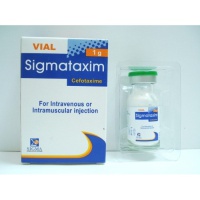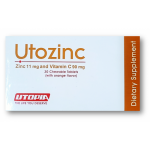
Sigmataxim
Vial IV/IM Injection
Composition:
Each vial of Sigmataxim 0.5 g contains 524 mg cefotaxime sodium as dry substance equival 500 mg cefotaxime.
Each vial of Sigmataxim 1.0 g contains 1.048 g cefotaxime sodium as dry substance equival 1.0 g cefotaxime.
Properties:
Sigmataxim is an antibiotic of the cephalosporin group and has a bactericidal effect. Its antiba activity against gram-negative rod-shaped bacteria is much more stronger than that of the cephalosporins and penicillins, and in most pathogens its minimum bactericidal concentra slightly higher than its minimum inhibitory concentration. Sigmataxim serum protein binding is 32-50 % depending on the method used. The sodium cc of Sigmataxim is 2.09 mmol/g.
Sigmataxim 1.0 g produces high serum levels that exceed the sensitivity of most pathc Sigmataxim has a good tissue penetration. It is excreted mainly through the kidney in an active
Indications:
Severe infection caused by cefotaxime-sensitive pathogens:
– Infections of the respiratory tract, induding nose and throat.
– Infections of the ear.
– Infections of the kidney and urinary tract.
– Infections of the skin and soft tissues.
– Infections of the bones and joints.
– Infections of the genital organs, induding gonorrhoea. (Sigmataxim 0.5 g and ‘Sigmataxim 1.C used in the treatment of gonorrhoea in adults).
– Infections of the abdominal region (Peritonitis, infections of the bile ducts and Sepsis, endocarditis, meningitis. – Gynaecological and obstetric infections.
– Infections of bums and other injuries.
– For the prophylaxis of infections of patients, with reduced resistance (e.g, under immunosuppn treatment or in the presence of neutropenia).
Surgical prophylaxis:
Gastrointestinal surgery.
Genitourinary surgery.
Obstetric and gynaecological surgery.
Cefotaxime is generally effective against the following pathogens:
Staphylococci, aerobic and anaerobic, Streptococcus pneumoniae, Neisseria spp., Haemo influnzae, Escherichia coli, Citrobacter spp., Salmonella spp., Klebsiella spp., Enterot
aerogenes, Serratia spp., indole-positive and indole-negatiye Proteus spp., Yersinia enterocc Cilostridium spp., and Bacteroides spp.
Pathogens with varying susceptibility are: Streptococcus faecalis, Enterobacter cia Pseudomonas aeruginosa and Bacteroids fragilis. There is not yet sufficient clinical experience with Salmonella typhi and paratyphi A and B infe<
Cefotaxime is not effective against: Treponema pallidum and Clostridium di1 Combined treatment: In severe,tife-threatening infections. the combination of Sigmataxir
aminoglycosides is indicated without awaiting the results of sensitivity test. The two prepar must be administered separately, not mixed in one syringe. Infections with Pseudomonas aeruginosa may require concomitant treatment with other antil effective against Pseudomonas.
Contraindications:
Hypersensitivity to cephalosporins.
Precautions:
In patients hypersensitive to penicillins, the possibility of cross sensitivity exists. In case of combination with aminoglycosides, renal functions must be evaluated.
Adverse Reaction:
Effects on the blood picture:
Thrombocytopenia, eosinophilia and leukopenia. As with other beta-lactam antibiotics; -granulocytopenia and, more rarely, agranulocytosis may develop during treatment with Sigmataxim particularly if given over long periods. For courses of treatment lasting longer than 10 days, blood count should therefore be monitored. Rare cases of hemolytic anemia have been reported.
Hypersensitivity reactions:
Urticaria, drug fever, interstitial nephritis (in rare cases) and anaphylaxis may occur. Anaphylactic shock is life-threatening and requires emergency treatment (see below).
Effect on the liver:
Transient rise in serum liver enzyme levels (SGOT, SGPT, Alkaline phosphatase).
Effects on the gastrointestinal tract:
Nausea, vomiting, and diarrhea. In cases of severe and persistent diarrhea (which may be life- threatening), antibiotic induced pseudomembranous colitis should be suspected. In such cases, Sigmataxim should be discontinued immediately and suitable treatment initiated (e.g. vancomycin oral). Peristalsis-inhibiting drugs are contraindicated.
Local reactions:
Inflammatory irritation and pain at the site of injection.
Other reactions:
As with other broad-spectrum antibiotics, a superinfection may occur.
Interactions:
Effects on laboratory parameters:
In rare cases, the direct Coomb’s test may give false positive results in patients on Sigmataxim treatment. False positive results may be obtained for urinary glucose, if it is determined by reduction methods; this can be avoided by using enzymatic methods.
Dosage & Mode of administration:
Dosage, mode of administration and intervals between injections depend on the severity of the infection, sensitivity of the pathogens and condition of the patient.
Dosage in infants and children up to 12 years old: (Sigmataxim 0.5 g).
Unless, otherwise prescribed, the following doses are used: .
Infants and children up to 12 years old: 50 – 100 mg I Kg body weight daily, divided into several equal doses at intervals of 6-12 hours. In some cases, life-threatening infections were treated with daily quantities of 150 – 200 mg I Kg body weight, which were well tolerated. In premature infants, renal clearance is not yet fully developed, therefore daily doses of 50 mg/ Kg body weight should not be exceeded.
For the pre-operative prophylaxis of infection, one of the above single doses is administered before the start of surgery. Depending on the risk of infection, the same dose may be repeated after an interval of 12 hours.
Dosage in children over 12 years old and adults: (Sigmataxim 0.5 9 and Sigmataxim 1.0 g)
Unless otherwise prescribed, children over 12 years and adults are given one vial of Sigmataxim 1.0 gm every 12 hours. In severe infections, the daily dose may be raised to a maximum of 12 g. If the daily dose is 4 g, it may be divided into 2 doses of 2 g each, administered at intervals of 12 hours. For higher daily doses the intervals are reduced to 8 or 6 hours.
For the treatment of gonorrhoea: A single dose of 0.5 9 Sigmataxim (e.g. 1 vial Sigmataxim 0.5) is administered intra muscularly. Before the start of therapy the patient should be examined for syphilis. Dosage in surgical prophylaxis
Usual dosage in adults:
1 9 LM or IV during induction of anaethesia. The duration at post-operative treatment must not exceed 24 hours.
Caesarian section:
1 9 LV at clamping of the umbilical cord, followed by 1 9 LM or IV, 6 and 12 hours after the first dose.
Dosage in patients with impaired renal function:
In patients with a creatinine clearance of ~ 5 mll minute.
The maintenance dose should be reduced to half the normal dose. The initial dose depends on the sensitivity of the pathogens and the severity of the infection. These dosage recommendations are based on experience in adults.
Mode and duration of Administration:
Sigmataxim solutions should be administered as soon as they have been prepared. A pale yellowish color of the solution does not mean impairment at the antibiotic efficacy.
The duration of treatment depends on the patient’s response. It must be continued for at least three days after normalization of the body temperature. Sodium bicarbonate solution must not be mixed with Sigmataxim.
Administration of Sigmataxim 0.5 g:
Sigmataxim 0.5 g is injected preferably by the intravenous route. The required dose is dissolved in at least 2 ml water for Sigmataxim injection and then injected over a period of 3 – 5 minutes either directly into a vein or into the distal part of a damped off Infusion tube.
Sigmataxim 0.5 g injected intramuscularly in adults in cases of gonorrhoea. For LM injections, the contents of one vial are dissolved in 2 ml water for injection and should then
be injected deep into the gluteus muscle. Pain resulting from LM injection can be prevented by dissolving Sigmataxim 0.5 9 in 2 mllidocaine solution 1 %. An intravascular injection must then be strictly avoided.
Administration of Sigmataxim 1.0 g:
Intravenous injection:
For intravenous injection the contents of one vial Sigmataxim 1.0 9 are dissolved in at least 4 ml water for injection and then injected over a period of 3 minutes either directly into a vein or into the distal part of a clamped-off infusion tube.
Intravenous infusion:
Higher doses may also be administered by intravenous infusion. For short infusions, 2 vials Sigmataxim 1.0 9 are dissolved in 40 ml water for injection or one of the infusion solutions (e.g 10 percent glucose solution, Haemaccel, Macrodex, Rheomacrodex) and infused in approximately
20 minutes. For continuous intravenous drip infusion, 2 vials Sigmataxim 1.0 9 are dissolved in 100 ml of an isotonic saline or glucose solution and infused within 50 – 60 minutes. Also any of the above mentioned infusion solutions may be used as a solvent.
Intramuscular administration:
For intramuscular injection, one vial of Sigmataxim 1.0 9 is dissolved in 4 ml water for injections, and then injected deep into the gluteus muscle. Pain resulting from the LM injection can be prevented by dissolving Sigmataxim 1.0 9 in 4 mllignocaine solution 1 %.An intravascular injection must then be strictly avoided. It is advisable not to inject more than 4 ml into either side. If the daily dose exceeds 2 g or if Sigmataxim 1.0 g is administered more than twice daily, intravenous injection is to be preferred.
Special Notes:
Emergency measures to be taken if anaphylactic shock occurs. The following measures are generally recommended: At the first signs of anaphylactic shock (sweating, nausea, cyanosis) stop the injection immediately but leave the venous cannula in place or perform venous cannulation. In addition to the usual emergency measures, ensure that the patient is kept flat with the legs raised and airways patent.
Emergency drug therapy:
Immediate epinephrine (adrenaline) i.v.: dilute 1 ml of commercially available epinephrine solution 1:1000 to 10 ml. In the first instance slowly inject 1 ml of this dilution (equivalent to 0.1 mg epinephrine) while monitoring pulse and blood pressure (watch for disturbances of cardiac rhythm). The administration of epinephrine may be repeated. Then glucocorticoids Lv.:e.g 250 -1000.mg methylprednisolone. The glu=rticoid administration may be repeated. Subsequently volume substitution i.v: e.g. plasma expanders, human albumin, balanced electrolyte solution.
Other therapeutic measures: artificial respiration, oxygen inhalation, calcium, antihistaminics.
Storage:
Store at temperature not exceeding 25°C, away from light.
Reconstituted solution is stable for 24 hours at temperature 2
Expiry Date:
The dry substance remains fit for use up to the date of expiry printed on the pack, if stored as directed. After that date it must be discarded.
Keep medicines out of the reach of children.
Presentation:
Sigmataxim 0.5 9 : 1 vial of 524 mg dry substance.
Sigmataxim 1.0 g: 1 vial of 1048 mg dry substance.
Produced by:
Sigma-Tec Pharmaceutical Industries. Egypt. S.A.E.

